Abstract
The relationship between the plasma triglycerides and the LDL triglycerides of 30 normal and 48 hypertriglyceridemic subjects has been quantified; the data fit a simple adsorption isotherm, LDL triglyceride/(LDL triglyceride+LDL cholesterol ester) = 0.65 plasma triglyceride/(464 + plasma triglyceride). In vitro transfer of triglyceride from concentrated VLDL to VLDL-depleted plasma produced triglyceride-rich LDL that had similar properties. LDL uptake by HepG2 cells increased with LDL triglyceride content whereas the reverse was found with skin fibroblasts. At 37 degrees C, the cores of both normal and hypertriglyceridemic LDL were isotropic liquids. Circular dichroic spectra revealed no difference in the secondary structure of normal and triglyceride-rich LDL. The affinity of monoclonal antibody MB47, which binds to the receptor ligand of apo B-100 was independent of LDL triglyceride content. MB3, which binds near residue 1022 of apo B-100, showed a triglyceride-dependent decrease in affinity for LDL from hypertriglyceridemic subjects and from in vitro incubations. LDL with an elevated triglyceride content formed in vitro had reduced proteolytic cleavage of apo B-100 by Staphylococcus aureus V8 protease. From these data, we infer that (a) LDL triglyceride is a predictable function of plasma triglyceride, (b) triglyceride induces subtle changes in apo B-100 structure at a site that is remote from the putative receptor binding ligand, and (c) the triglyceride-dependent receptor-binding determinants of apo B-100 are recognized differently by fibroblasts and HepG2 cells.
Full text
PDF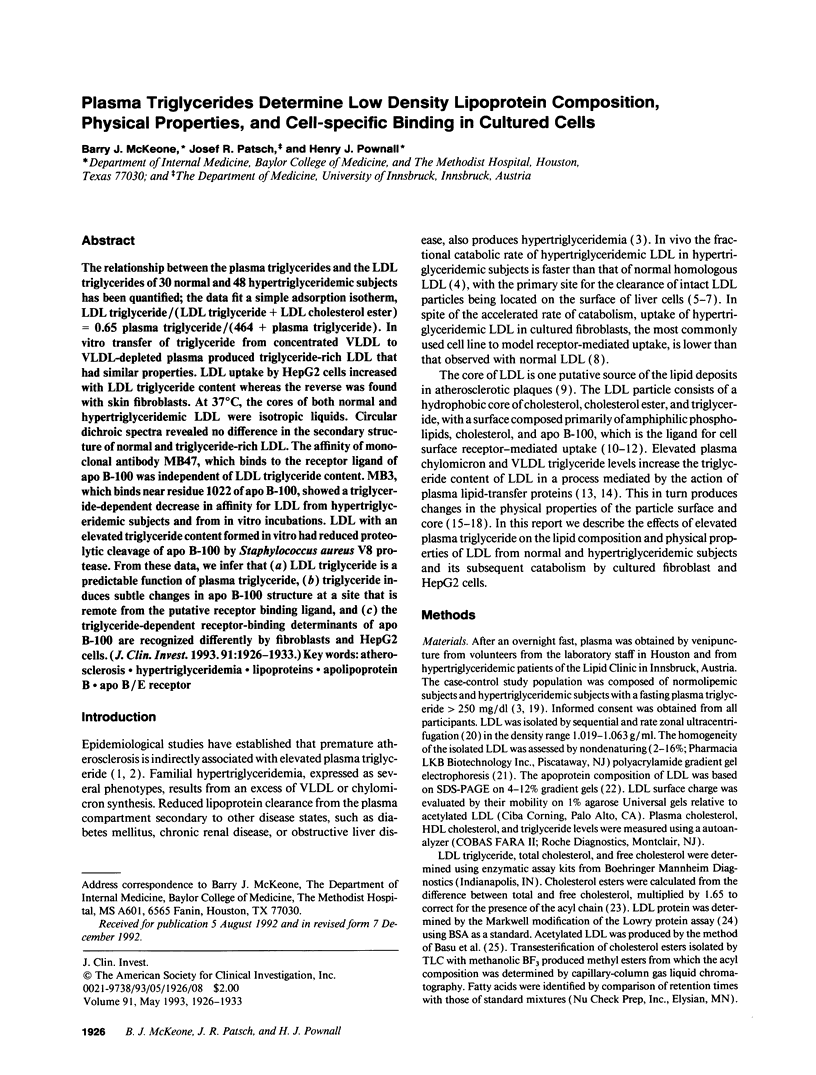
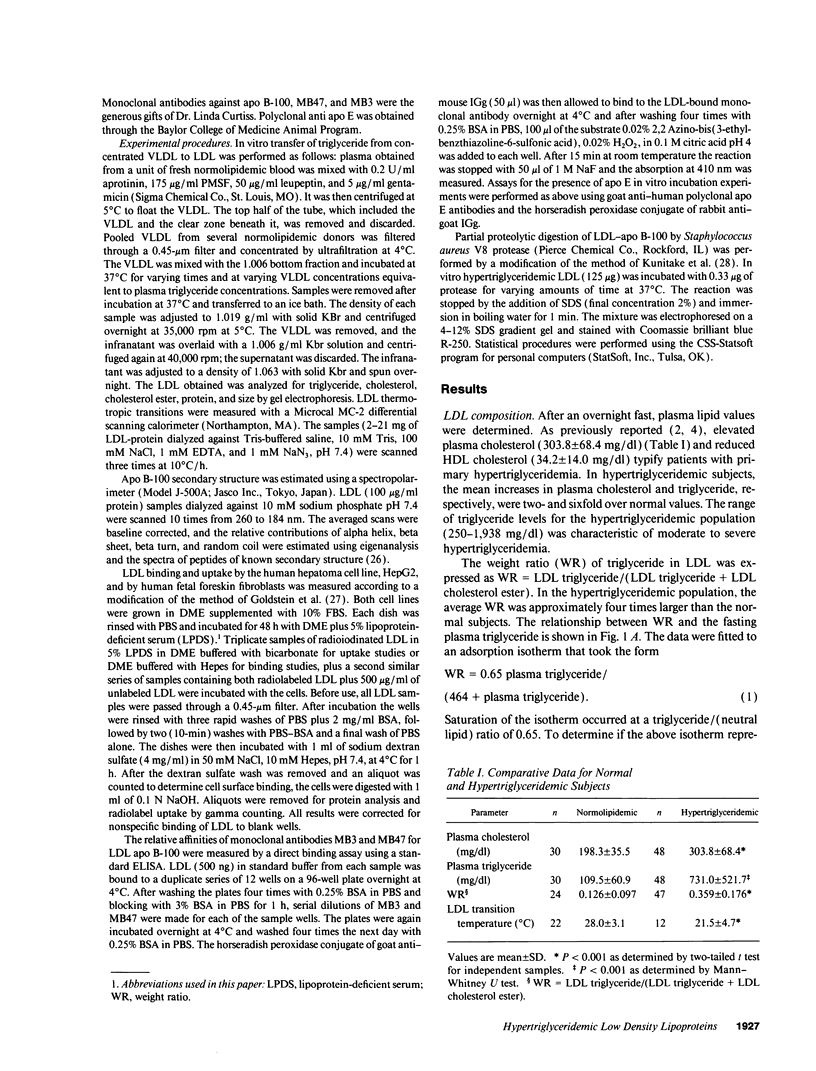
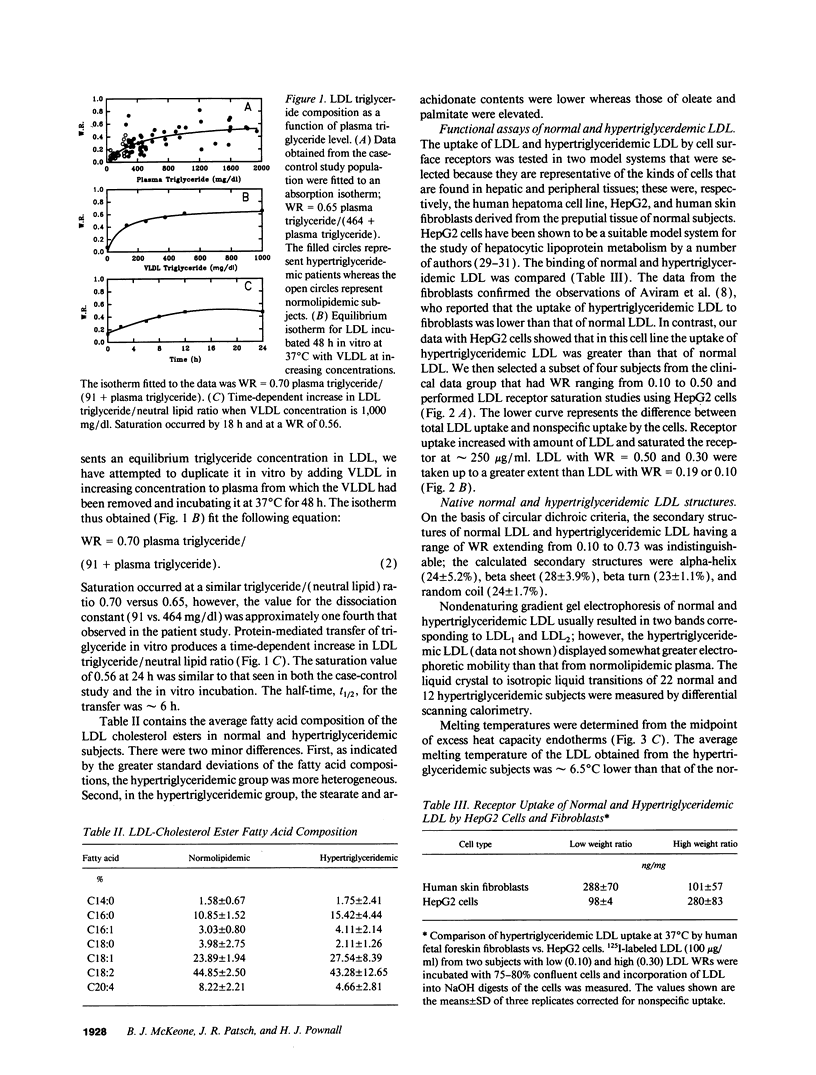
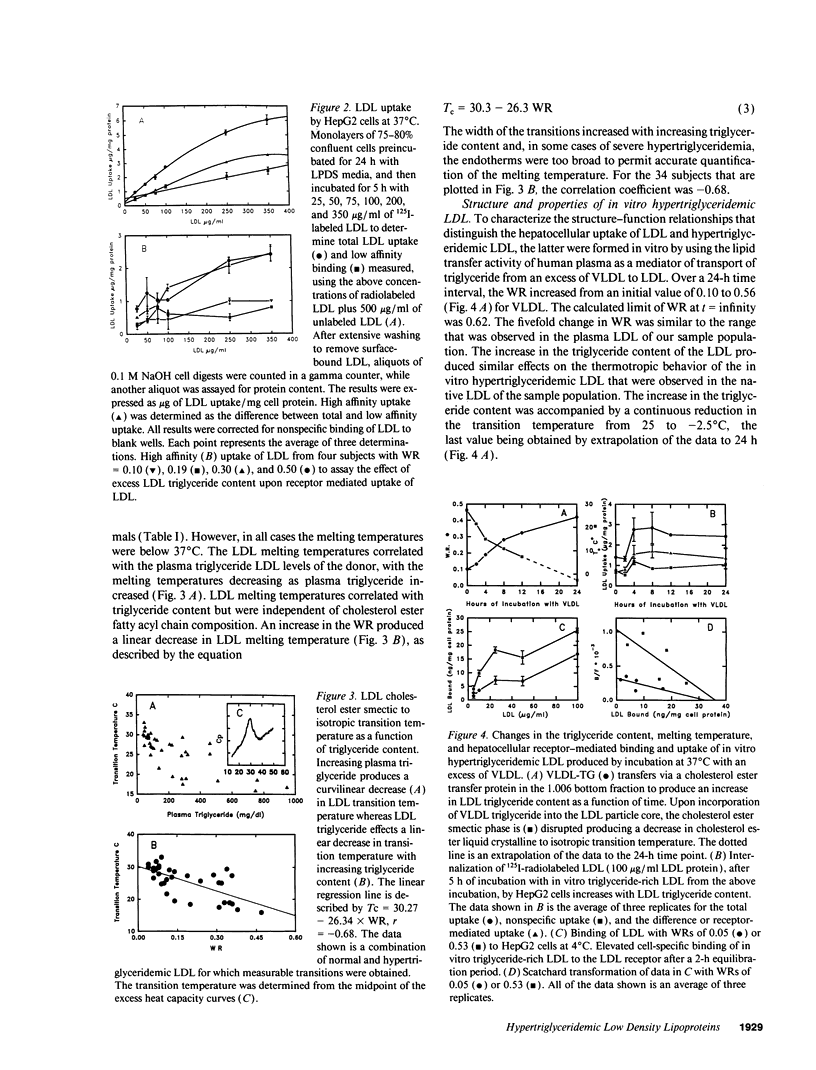
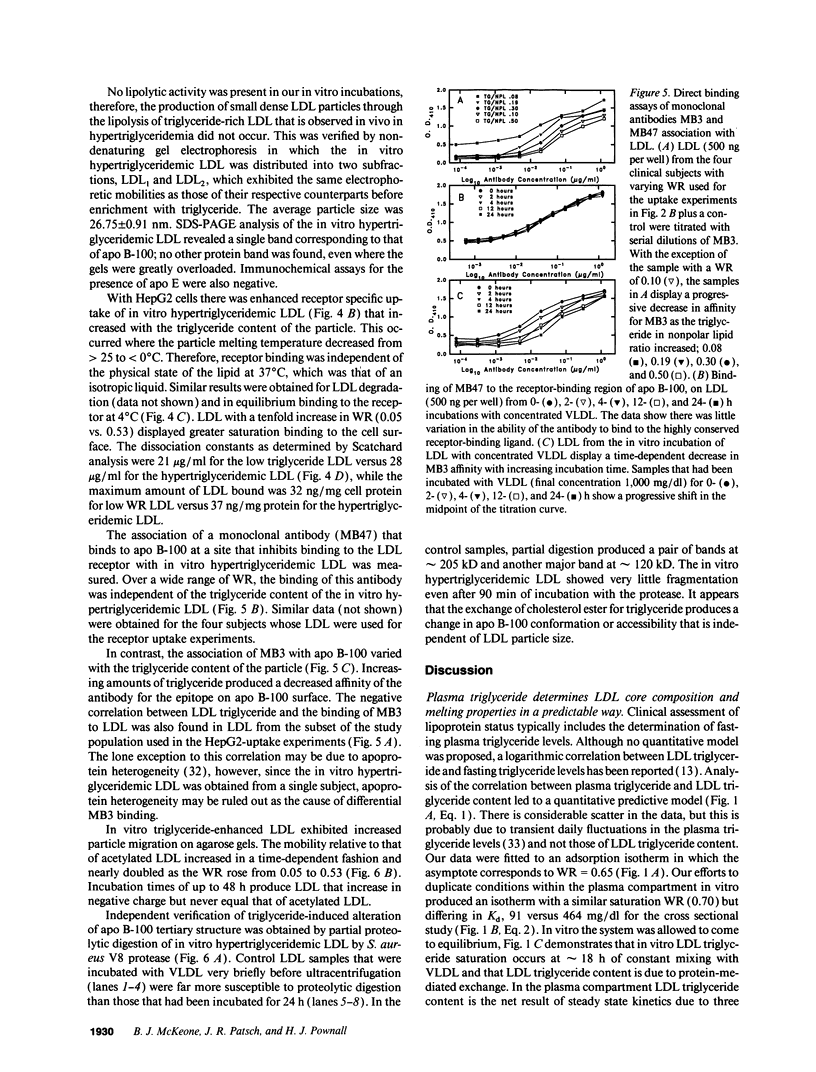
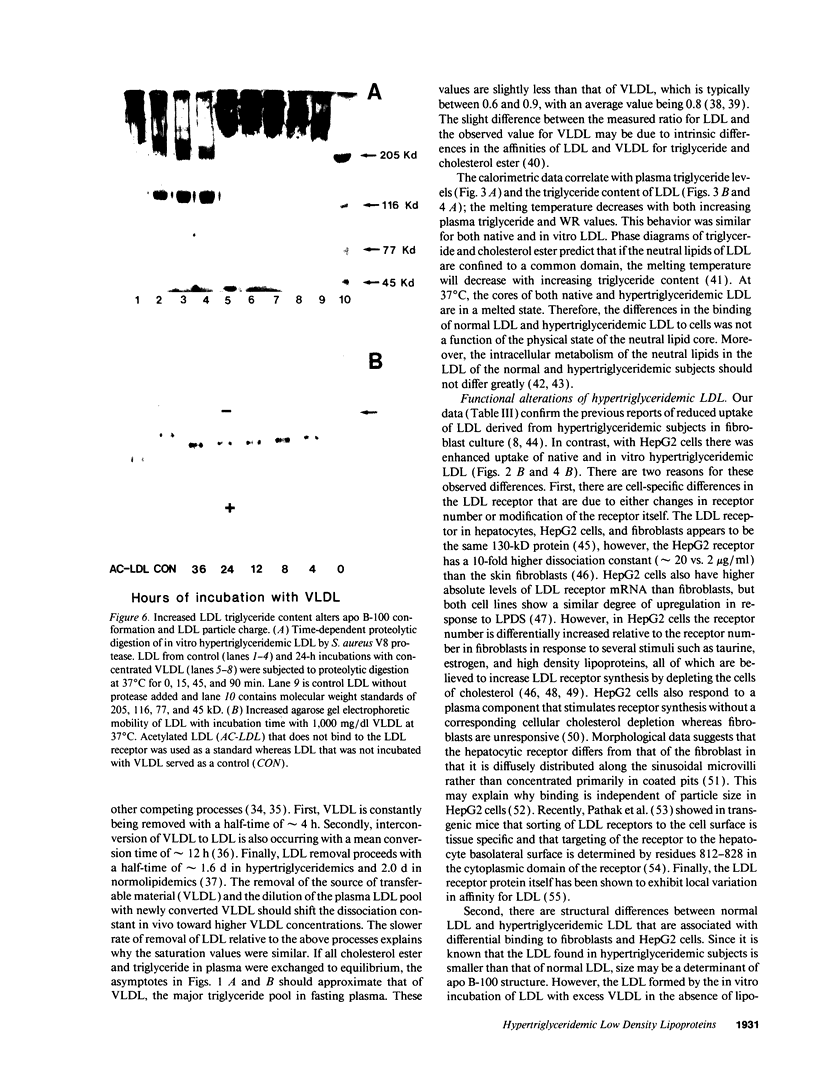
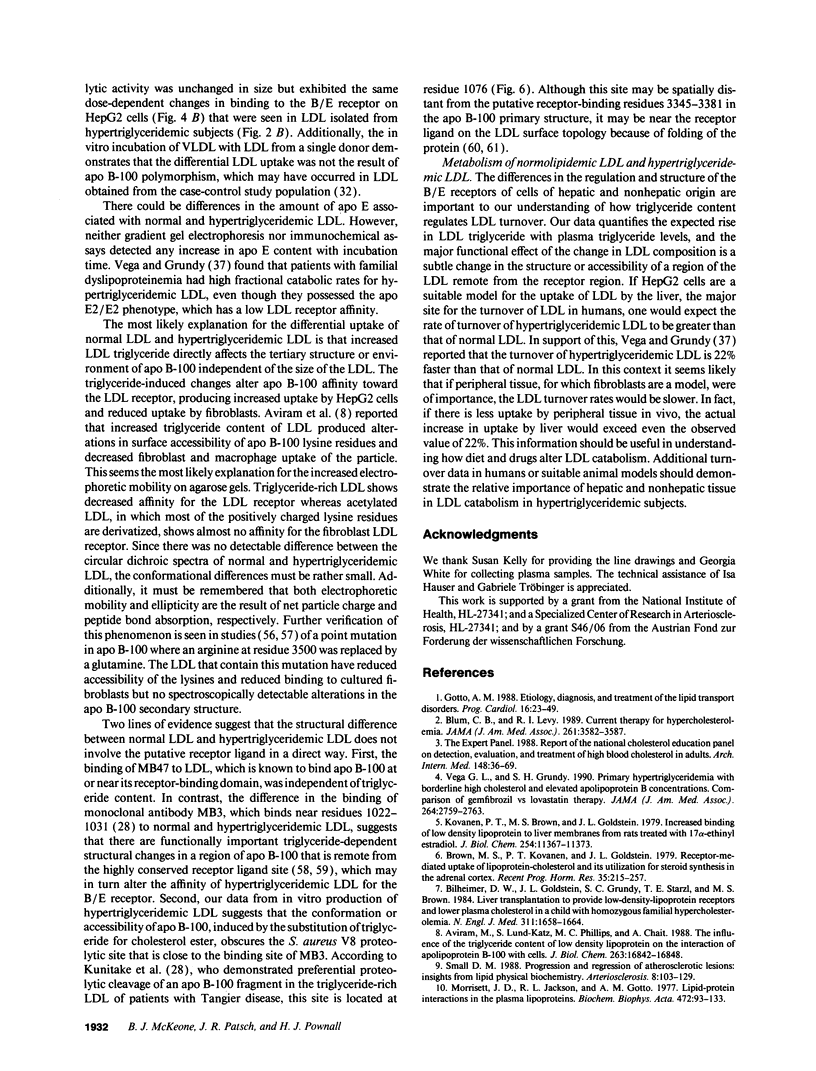
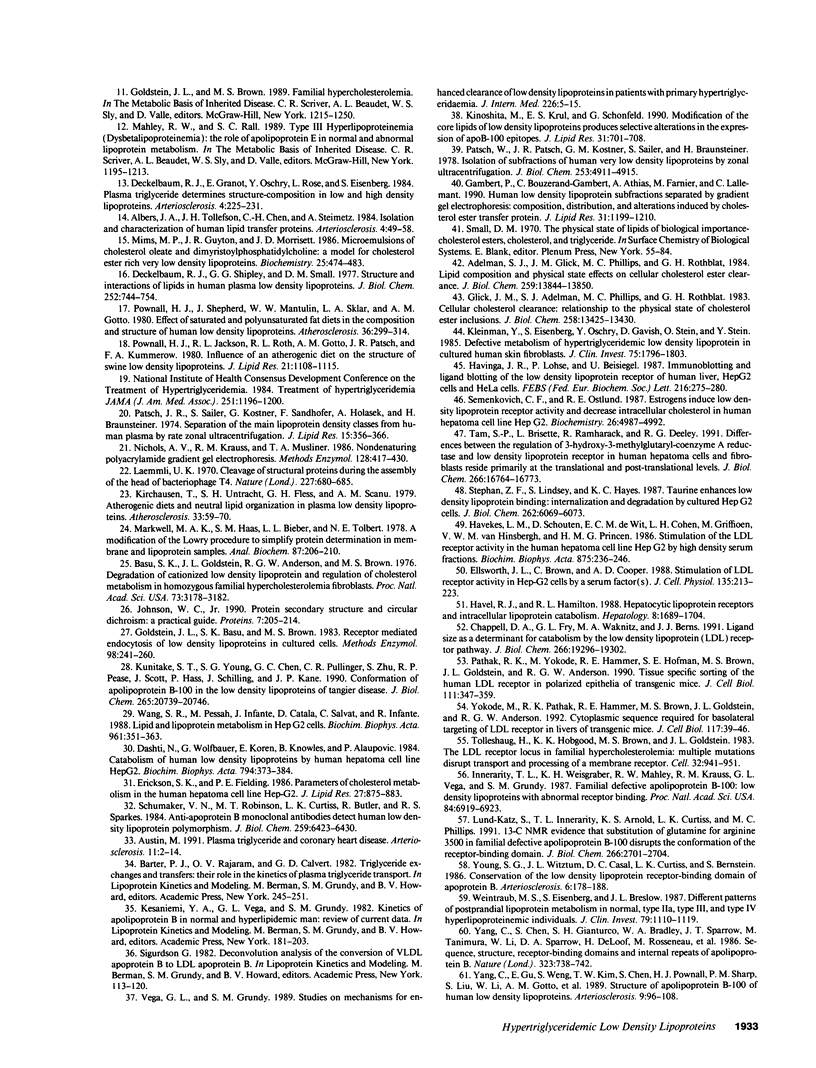
Images in this article
Selected References
These references are in PubMed. This may not be the complete list of references from this article.
- Adelman S. J., Glick J. M., Phillips M. C., Rothblat G. H. Lipid composition and physical state effects on cellular cholesteryl ester clearance. J Biol Chem. 1984 Nov 25;259(22):13844–13850. [PubMed] [Google Scholar]
- Albers J. J., Tollefson J. H., Chen C. H., Steinmetz A. Isolation and characterization of human plasma lipid transfer proteins. Arteriosclerosis. 1984 Jan-Feb;4(1):49–58. doi: 10.1161/01.atv.4.1.49. [DOI] [PubMed] [Google Scholar]
- Austin M. A. Plasma triglyceride and coronary heart disease. Arterioscler Thromb. 1991 Jan-Feb;11(1):2–14. doi: 10.1161/01.atv.11.1.2. [DOI] [PubMed] [Google Scholar]
- Aviram M., Lund-Katz S., Phillips M. C., Chait A. The influence of the triglyceride content of low density lipoprotein on the interaction of apolipoprotein B-100 with cells. J Biol Chem. 1988 Nov 15;263(32):16842–16848. [PubMed] [Google Scholar]
- Basu S. K., Goldstein J. L., Anderson G. W., Brown M. S. Degradation of cationized low density lipoprotein and regulation of cholesterol metabolism in homozygous familial hypercholesterolemia fibroblasts. Proc Natl Acad Sci U S A. 1976 Sep;73(9):3178–3182. doi: 10.1073/pnas.73.9.3178. [DOI] [PMC free article] [PubMed] [Google Scholar]
- Bilheimer D. W., Goldstein J. L., Grundy S. M., Starzl T. E., Brown M. S. Liver transplantation to provide low-density-lipoprotein receptors and lower plasma cholesterol in a child with homozygous familial hypercholesterolemia. N Engl J Med. 1984 Dec 27;311(26):1658–1664. doi: 10.1056/NEJM198412273112603. [DOI] [PMC free article] [PubMed] [Google Scholar]
- Blum C. B., Levy R. I. Current therapy for hypercholesterolemia. JAMA. 1989 Jun 23;261(24):3582–3587. [PubMed] [Google Scholar]
- Brown M. S., Kovanen P. T., Goldstein J. L. Receptor-mediated uptake of lipoprotein-cholesterol and its utilization for steroid synthesis in the adrenal cortex. Recent Prog Horm Res. 1979;35:215–257. doi: 10.1016/b978-0-12-571135-7.50009-6. [DOI] [PubMed] [Google Scholar]
- Chappell D. A., Fry G. L., Waknitz M. A., Berns J. J. Ligand size as a determinant for catabolism by the low density lipoprotein (LDL) receptor pathway. A lattice model for LDL binding. J Biol Chem. 1991 Oct 15;266(29):19296–19302. [PubMed] [Google Scholar]
- Dashti N., Wolfbauer G., Koren E., Knowles B., Alaupovic P. Catabolism of human low density lipoproteins by human hepatoma cell line HepG2. Biochim Biophys Acta. 1984 Jul 26;794(3):373–384. doi: 10.1016/0005-2760(84)90003-1. [DOI] [PubMed] [Google Scholar]
- Deckelbaum R. J., Granot E., Oschry Y., Rose L., Eisenberg S. Plasma triglyceride determines structure-composition in low and high density lipoproteins. Arteriosclerosis. 1984 May-Jun;4(3):225–231. doi: 10.1161/01.atv.4.3.225. [DOI] [PubMed] [Google Scholar]
- Deckelbaum R. J., Shipley G. G., Small D. M. Structure and interactions of lipids in human plasma low density lipoproteins. J Biol Chem. 1977 Jan 25;252(2):744–754. [PubMed] [Google Scholar]
- Ellsworth J. L., Brown C., Cooper A. D. Stimulation of LDL receptor activity in Hep-G2 cells by a serum factor(s). J Cell Physiol. 1988 May;135(2):213–223. doi: 10.1002/jcp.1041350208. [DOI] [PubMed] [Google Scholar]
- Erickson S. K., Fielding P. E. Parameters of cholesterol metabolism in the human hepatoma cell line, Hep-G2. J Lipid Res. 1986 Aug;27(8):875–883. [PubMed] [Google Scholar]
- Gambert P., Bouzerand-Gambert C., Athias A., Farnier M., Lallemant C. Human low density lipoprotein subfractions separated by gradient gel electrophoresis: composition, distribution, and alterations induced by cholesteryl ester transfer protein. J Lipid Res. 1990 Jul;31(7):1199–1210. [PubMed] [Google Scholar]
- Glick J. M., Adelman S. J., Phillips M. C., Rothblat G. H. Cellular cholesteryl ester clearance. Relationship to the physical state of cholesteryl ester inclusions. J Biol Chem. 1983 Nov 25;258(22):13425–13430. [PubMed] [Google Scholar]
- Goldstein J. L., Basu S. K., Brown M. S. Receptor-mediated endocytosis of low-density lipoprotein in cultured cells. Methods Enzymol. 1983;98:241–260. doi: 10.1016/0076-6879(83)98152-1. [DOI] [PubMed] [Google Scholar]
- Havekes L. M., Schouten D., de Wit E. C., Cohen L. H., Griffioen M., van Hinsbergh V. W., Princen H. M. Stimulation of the LDL receptor activity in the human hepatoma cell line Hep G2 by high-density serum fractions. Biochim Biophys Acta. 1986 Feb 12;875(2):236–246. doi: 10.1016/0005-2760(86)90173-6. [DOI] [PubMed] [Google Scholar]
- Havel R. J., Hamilton R. L. Hepatocytic lipoprotein receptors and intracellular lipoprotein catabolism. Hepatology. 1988 Nov-Dec;8(6):1689–1704. doi: 10.1002/hep.1840080637. [DOI] [PubMed] [Google Scholar]
- Havinga J. R., Lohse P., Beisiegel U. Immunoblotting and ligand blotting of the low-density lipoprotein receptor of human liver, HepG2 cells and HeLa cells. FEBS Lett. 1987 Jun 1;216(2):275–280. doi: 10.1016/0014-5793(87)80705-6. [DOI] [PubMed] [Google Scholar]
- Innerarity T. L., Weisgraber K. H., Arnold K. S., Mahley R. W., Krauss R. M., Vega G. L., Grundy S. M. Familial defective apolipoprotein B-100: low density lipoproteins with abnormal receptor binding. Proc Natl Acad Sci U S A. 1987 Oct;84(19):6919–6923. doi: 10.1073/pnas.84.19.6919. [DOI] [PMC free article] [PubMed] [Google Scholar]
- Johnson W. C., Jr Protein secondary structure and circular dichroism: a practical guide. Proteins. 1990;7(3):205–214. doi: 10.1002/prot.340070302. [DOI] [PubMed] [Google Scholar]
- Kinoshita M., Krul E. S., Schonfeld G. Modification of the core lipids of low density lipoproteins produces selective alterations in the expression of apoB-100 epitopes. J Lipid Res. 1990 Apr;31(4):701–708. [PubMed] [Google Scholar]
- Kirchhausen T., Untracht S. H., Fless G. M., Scanu A. M. Atherogenic diets and neutral-lipid organization in plasma low density lipoproteins. Atherosclerosis. 1979 May;33(1):59–70. doi: 10.1016/0021-9150(79)90198-9. [DOI] [PubMed] [Google Scholar]
- Kleinman Y., Eisenberg S., Oschry Y., Gavish D., Stein O., Stein Y. Defective metabolism of hypertriglyceridemic low density lipoprotein in cultured human skin fibroblasts. Normalization with bezafibrate therapy. J Clin Invest. 1985 Jun;75(6):1796–1803. doi: 10.1172/JCI111892. [DOI] [PMC free article] [PubMed] [Google Scholar]
- Kovanen P. T., Brown M. S., Goldstein J. L. Increased binding of low density lipoprotein to liver membranes from rats treated with 17 alpha-ethinyl estradiol. J Biol Chem. 1979 Nov 25;254(22):11367–11373. [PubMed] [Google Scholar]
- Kunitake S. T., Young S. G., Chen G. C., Pullinger C. R., Zhu S., Pease R. J., Scott J., Hass P., Schilling J., Kane J. P. Conformation of apolipoprotein B-100 in the low density lipoproteins of tangier disease. Identification of localized conformational response to triglyceride content. J Biol Chem. 1990 Dec 5;265(34):20739–20746. [PubMed] [Google Scholar]
- Laemmli U. K. Cleavage of structural proteins during the assembly of the head of bacteriophage T4. Nature. 1970 Aug 15;227(5259):680–685. doi: 10.1038/227680a0. [DOI] [PubMed] [Google Scholar]
- Lund-Katz S., Innerarity T. L., Arnold K. S., Curtiss L. K., Phillips M. C. 13C NMR evidence that substitution of glutamine for arginine 3500 in familial defective apolipoprotein B-100 disrupts the conformation of the receptor-binding domain. J Biol Chem. 1991 Feb 15;266(5):2701–2704. [PubMed] [Google Scholar]
- Markwell M. A., Haas S. M., Bieber L. L., Tolbert N. E. A modification of the Lowry procedure to simplify protein determination in membrane and lipoprotein samples. Anal Biochem. 1978 Jun 15;87(1):206–210. doi: 10.1016/0003-2697(78)90586-9. [DOI] [PubMed] [Google Scholar]
- Mims M. P., Guyton J. R., Morrisett J. D. Microemulsions of cholesteryl oleate and dimyristoylphosphatidylcholine: a model for cholesteryl ester rich very low density lipoproteins. Biochemistry. 1986 Jan 28;25(2):474–483. doi: 10.1021/bi00350a030. [DOI] [PubMed] [Google Scholar]
- Morrisett J. D., Jackson R. L., Gotto A. M., Jr Lipid-protein interactions in the plasma lipoproteins. Biochim Biophys Acta. 1977 Aug 9;472(2):93–133. doi: 10.1016/0304-4157(77)90015-6. [DOI] [PubMed] [Google Scholar]
- Nichols A. V., Krauss R. M., Musliner T. A. Nondenaturing polyacrylamide gradient gel electrophoresis. Methods Enzymol. 1986;128:417–431. doi: 10.1016/0076-6879(86)28084-2. [DOI] [PubMed] [Google Scholar]
- Pathak R. K., Yokode M., Hammer R. E., Hofmann S. L., Brown M. S., Goldstein J. L., Anderson R. G. Tissue-specific sorting of the human LDL receptor in polarized epithelia of transgenic mice. J Cell Biol. 1990 Aug;111(2):347–359. doi: 10.1083/jcb.111.2.347. [DOI] [PMC free article] [PubMed] [Google Scholar]
- Patsch J. R., Sailer S., Kostner G., Sandhofer F., Holasek A., Braunsteiner H. Separation of the main lipoprotein density classes from human plasma by rate-zonal ultracentrifugation. J Lipid Res. 1974 Jul;15(4):356–366. [PubMed] [Google Scholar]
- Patsch W., Patsch J. R., Kostner G. M., Sailer S., Braunsteiner H. Isolation of subfractions of human very low density lipoproteins by zonal ultracentrifugation. J Biol Chem. 1978 Jul 25;253(14):4911–4915. [PubMed] [Google Scholar]
- Pownall H. J., Jackson R. L., Roth R. I., Gotto A. M., Patsch J. R., Kummerow F. A. Influence of an atherogenic diet on the structure of swine low density lipoproteins. J Lipid Res. 1980 Nov;21(8):1108–1115. [PubMed] [Google Scholar]
- Schumaker V. N., Robinson M. T., Curtiss L. K., Butler R., Sparkes R. S. Anti-apoprotein B monoclonal antibodies detect human low density lipoprotein polymorphism. J Biol Chem. 1984 May 25;259(10):6423–6430. [PubMed] [Google Scholar]
- Semenkovich C. F., Ostlund R. E., Jr Estrogens induce low-density lipoprotein receptor activity and decrease intracellular cholesterol in human hepatoma cell line Hep G2. Biochemistry. 1987 Aug 11;26(16):4987–4992. doi: 10.1021/bi00390a016. [DOI] [PubMed] [Google Scholar]
- Small D. M. George Lyman Duff memorial lecture. Progression and regression of atherosclerotic lesions. Insights from lipid physical biochemistry. Arteriosclerosis. 1988 Mar-Apr;8(2):103–129. doi: 10.1161/01.atv.8.2.103. [DOI] [PubMed] [Google Scholar]
- Stephan Z. F., Lindsey S., Hayes K. C. Taurine enhances low density lipoprotein binding. Internalization and degradation by cultured Hep G2 cells. J Biol Chem. 1987 May 5;262(13):6069–6073. [PubMed] [Google Scholar]
- Tam S. P., Brissette L., Ramharack R., Deeley R. G. Differences between the regulation of 3-hydroxy-3-methylglutaryl-coenzyme A reductase and low density lipoprotein receptor in human hepatoma cells and fibroblasts reside primarily at the translational and post-translational levels. J Biol Chem. 1991 Sep 5;266(25):16764–16773. [PubMed] [Google Scholar]
- Tolleshaug H., Hobgood K. K., Brown M. S., Goldstein J. L. The LDL receptor locus in familial hypercholesterolemia: multiple mutations disrupt transport and processing of a membrane receptor. Cell. 1983 Mar;32(3):941–951. doi: 10.1016/0092-8674(83)90079-x. [DOI] [PubMed] [Google Scholar]
- Vega G. L., Grundy S. M. Primary hypertriglyceridemia with borderline high cholesterol and elevated apolipoprotein B concentrations. Comparison of gemfibrozil vs lovastatin therapy. JAMA. 1990 Dec 5;264(21):2759–2763. [PubMed] [Google Scholar]
- Vega G. L., Grundy S. M. Studies on mechanisms for enhanced clearance of low-density lipoproteins in patients with primary hypertriglyceridaemia. J Intern Med. 1989 Jul;226(1):5–15. doi: 10.1111/j.1365-2796.1989.tb01347.x. [DOI] [PubMed] [Google Scholar]
- Wang S. R., Pessah M., Infante J., Catala D., Salvat C., Infante R. Lipid and lipoprotein metabolism in Hep G2 cells. Biochim Biophys Acta. 1988 Aug 12;961(3):351–363. doi: 10.1016/0005-2760(88)90082-3. [DOI] [PubMed] [Google Scholar]
- Weintraub M. S., Eisenberg S., Breslow J. L. Different patterns of postprandial lipoprotein metabolism in normal, type IIa, type III, and type IV hyperlipoproteinemic individuals. Effects of treatment with cholestyramine and gemfibrozil. J Clin Invest. 1987 Apr;79(4):1110–1119. doi: 10.1172/JCI112926. [DOI] [PMC free article] [PubMed] [Google Scholar]
- Yang C. Y., Chen S. H., Gianturco S. H., Bradley W. A., Sparrow J. T., Tanimura M., Li W. H., Sparrow D. A., DeLoof H., Rosseneu M. Sequence, structure, receptor-binding domains and internal repeats of human apolipoprotein B-100. Nature. 1986 Oct 23;323(6090):738–742. doi: 10.1038/323738a0. [DOI] [PubMed] [Google Scholar]
- Yang C. Y., Gu Z. W., Weng S. A., Kim T. W., Chen S. H., Pownall H. J., Sharp P. M., Liu S. W., Li W. H., Gotto A. M., Jr Structure of apolipoprotein B-100 of human low density lipoproteins. Arteriosclerosis. 1989 Jan-Feb;9(1):96–108. doi: 10.1161/01.atv.9.1.96. [DOI] [PubMed] [Google Scholar]
- Yokode M., Pathak R. K., Hammer R. E., Brown M. S., Goldstein J. L., Anderson R. G. Cytoplasmic sequence required for basolateral targeting of LDL receptor in livers of transgenic mice. J Cell Biol. 1992 Apr;117(1):39–46. doi: 10.1083/jcb.117.1.39. [DOI] [PMC free article] [PubMed] [Google Scholar]
- Young S. G., Witztum J. L., Casal D. C., Curtiss L. K., Bernstein S. Conservation of the low density lipoprotein receptor-binding domain of apoprotein B. Demonstration by a new monoclonal antibody, MB47. Arteriosclerosis. 1986 Mar-Apr;6(2):178–188. doi: 10.1161/01.atv.6.2.178. [DOI] [PubMed] [Google Scholar]




